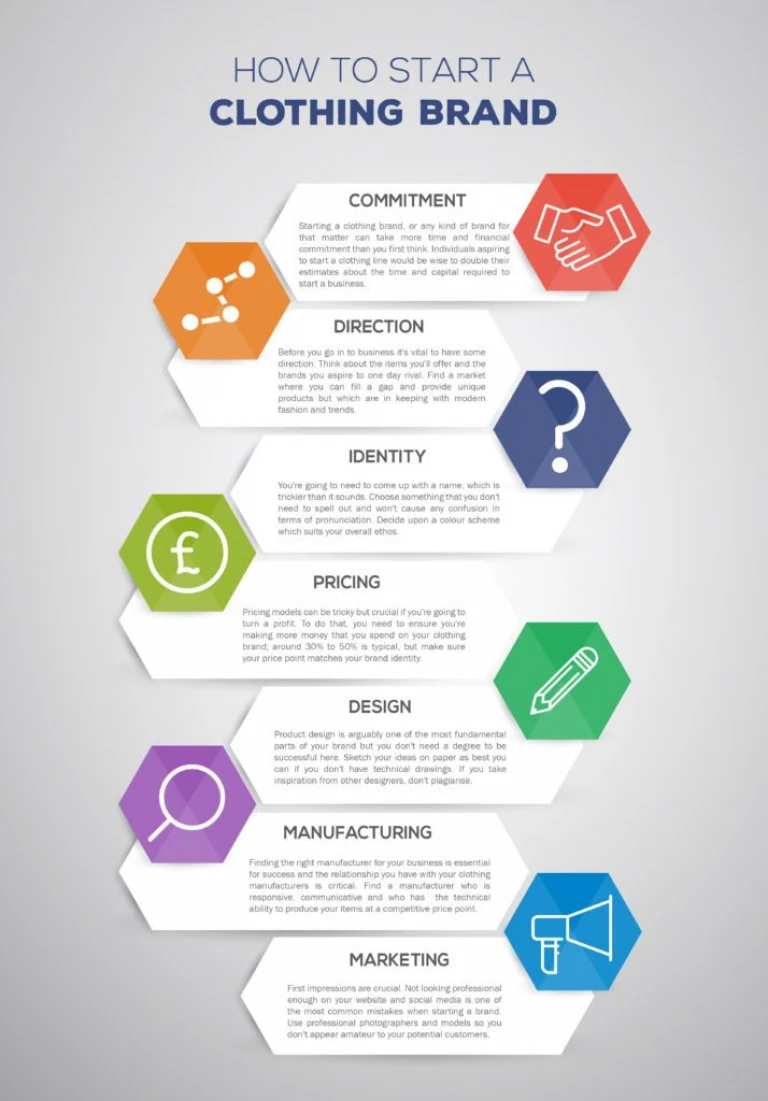How To Start A Clothing Brand
HOME / / How To Start A Clothing Brand
The infographic below helps explain some of the key steps which are involved in creating a brand. It comes from our friends at Hawthorn, who have a very thorough guide to starting a fashion brand on their website.

Step 1: Getting started
Starting a fashion brand isn't easy. You'll need artistic flair and business smarts to make a success. You'll also need time and money to get the ball rolling.
Fashion brand startup costs
Startup costs for a fashion brand include things like:
materials and production costs
marketing and branding
website development
photography
shipping
You may have to incur these costs before you even make a sale, so you will have to explore ways to fund your business.
Fashion brand startup timeline
In terms of time, you'll presumably start by creating designs and making prototypes yourself. You might be doing this in your spare time alongside other work. So it could take a while to start to build up a collection of clothes that you're ready to show off.
You need to make sure you understand just how long it could take you to get your products to market and start making sales, as this will help you create a realistic financial plan and cash flow forecast for your business.
Registering your fashion brand
Like any business in the UK, you need to decide on a legal structure and register with HMRC. Take a look at our guide to UK company formats and business structures.
Step 2: Identify the target market for your fashion brand
A clearly defined target market will help you create a brand that appeals to your ideal customer.
Segmenting the market
You can define your target market through a number of factors, such as:
Age and gender
Income bracket
Lifestyle and aspirations
Occupation
Marital or family status
Location (of customer)
Location (of purchase)
Try creating a customer persona that describes exactly who you are marketing to and what they want from your brand. This can really help focus your branding and marketing efforts.
Remember, never base your branding and marketing on a hunch. Always conduct market research.
Defining your fashion business brand
For a creative entrepreneur, defining your brand is one of the most exciting parts of starting a fashion brand. At the most basic level, you need to think about the following and how to create a brand that will appeal to your target market:
name and slogan
logo
brand colours
pricing
The importance of logos to fashion brands
Your logo is of paramount importance. When someone is wearing one of your garments, you want people to be able to see it is from your brand.
You need to think how to incorporate your brand into your garments in an appropriate way for your target market - for example, blazened across a hoodie in a graphic font or suggested by a subtle icon embroidered discretely.
Your logo helps:
brand loyalty, as people pay to be associated with your brand
brand recognition, so that people can identify your clothing and seek it out
Step 3: Deciding your fashion brand pricing
Pricing and brand perception
Fashion is one of those areas where pricing can seem completely unrelated to the cost of manufacture. A white t shirt from a supermarket does the same basic job as one from a designer. But the difference in price can be huge.
You'll need to think about the impact of pricing on brand perception. Do you want to be associated with affordable fast fashion or command a premium price tag to attract aspirational and affluent customers?
Pricing and costs
Your pricing obviously needs to cover your production, marketing and sales costs too. So remember to factor in the cost of:
manufacturing
taxes
packaging
promotion
shipping
any salary you are taking from the business
Step 4: Manufacture your products
Transmit Startups are experts in starting a business but we bow to the expertise of others when it comes to specifics like this. Take a look at the guide from Hawthorn for their very detailed information about fashion garment manufacturing.
Step 5: Promote and sell your products
There is a wide range of ways to promote and sell your products. You may choose to market your clothes direct to customers (ie via your own sales and distribution channels) or through an intermediary, like a shop or online retailer.
Either way, you'll need to create brand awareness and desire. Promotion opportunities include:
advertising and PR
influencer / affiliate marketing
digital and social media marketing
trade fairs and face-to-face sales
Step 6: Manage your business
Don't forget the important of managing your business. As you grow, you'll need proper admin processes in place to make sure you pay suppliers on time, invoice customers for the right amount, balance your book, pay your taxes, and adhere to any relevant legislation.
Write a business plan and a marketing plan to make sure you record your goals and how you'll achieve them
Find someone to manage your finances or use small business finance software to do it yourself
Register for self-assessment (if you're a sole trader) and complete your tax return each year
Keep an eye on your competitors and update your SWOT and PEST analysis each year
Know your responsibilities if you hire staff for your fashion business
Interested in taking out an affordable Start Up Loan to get your fashion label off the ground? See how much you can borrow with our Start Up Loan calculator.

"We’re delighted to be the 2000th loan recipients!"
